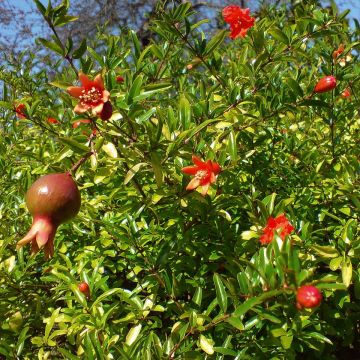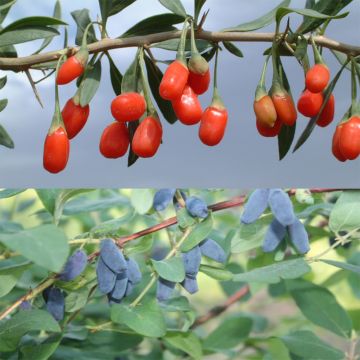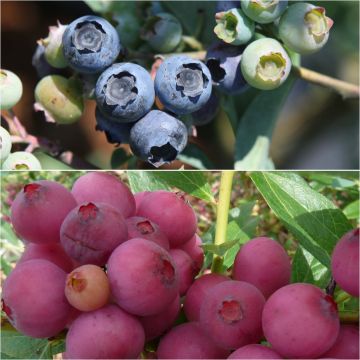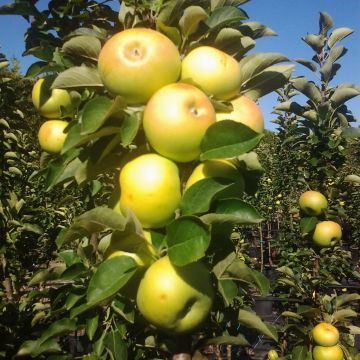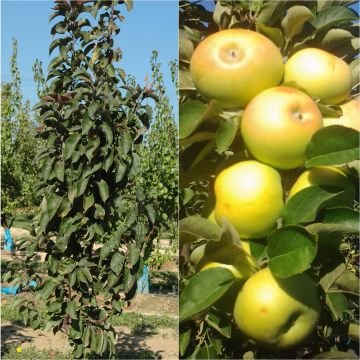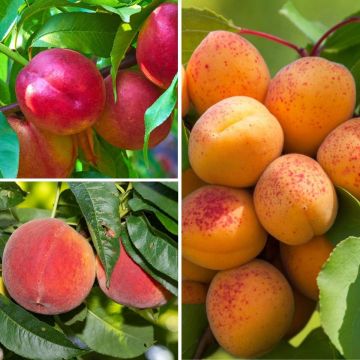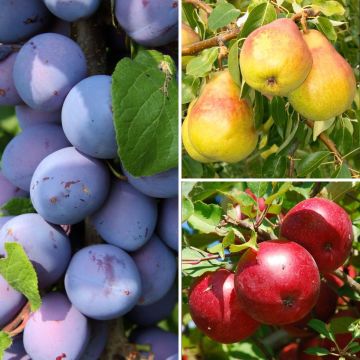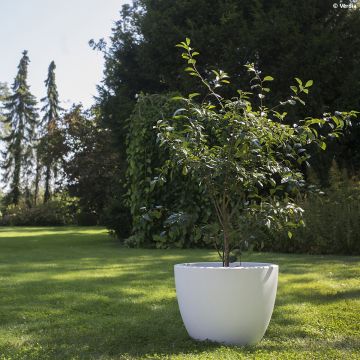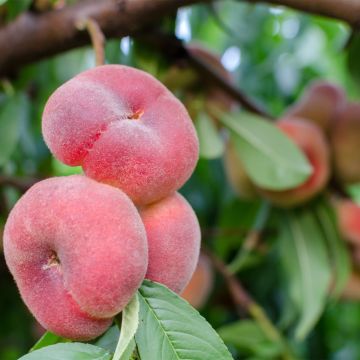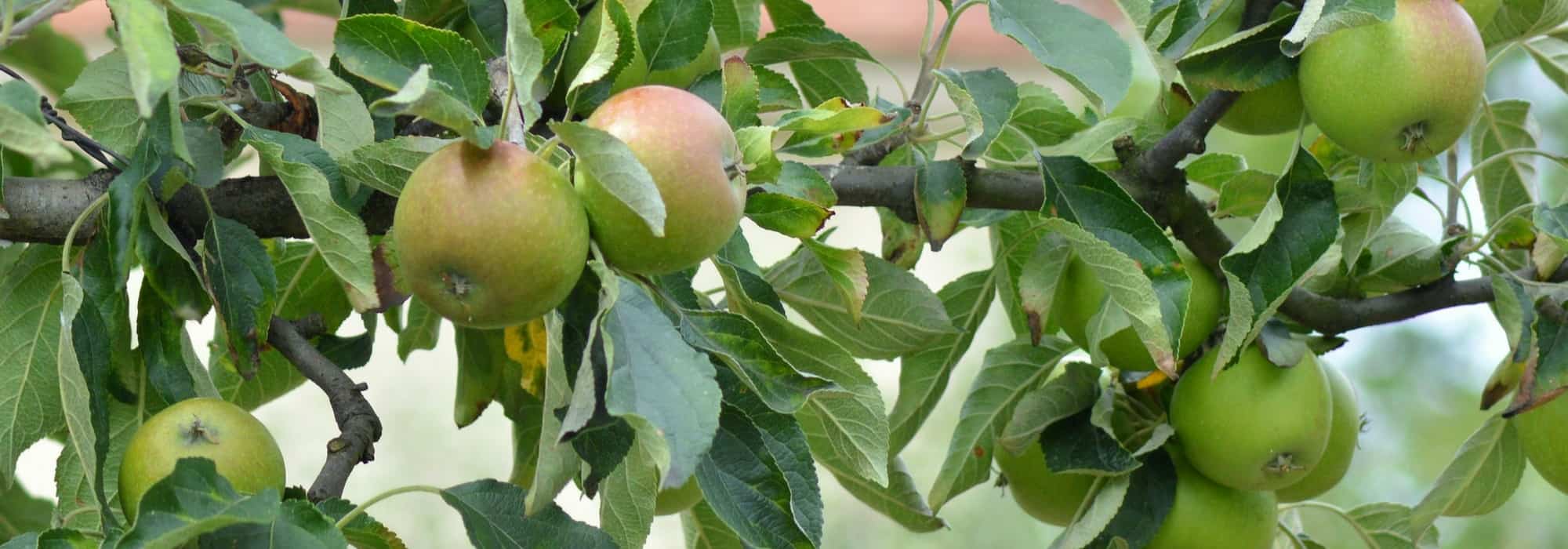
Dwarf fruit trees
ideal varieties for pots or small gardens
Contents
Dwarf fruit trees are small or miniature varieties that bear normal-sized fruit. Unlike most traditional fruit trees, these dwarf trees can be grown in pots, on balconies or terraces. Space-saving, they are also a boon in small gardens or within a vegetable patch where you can even grow them right among the vegetables.
Dwarf fruit trees, grafted onto a dwarfing rootstock, reach a maximum height of 2 metres, and often less.
The benefits of dwarf fruit trees
In addition to their compact size, ease of cultivation, and quick fruiting, these fruit trees offer the advantage of being decorative. Their small size also allows for:
- easy care in case of disease or pest attacks,
- equally easy protection, with a winter cover when a late frost occurs or with a bird net when theft becomes too frequent,
- the ability to be stored in winter (for citrus trees) or during severe cold spells, for the hardier varieties,
- the possibility of taking your miniature orchard with you in case of a move… a notable advantage when living in rented accommodation!
Choosing your dwarf fruit tree: the different varieties
Every year, new varieties expand the range of dwarf fruit trees. This now offers a beautiful diversity: dwarf apple, dwarf fig, pear, cherry, peach, fig… the most popular fruits can now be grown in pots!
Among the important selection criteria for a fruit tree is the self-fertile character of the variety. Indeed, if you choose a non-self-fertile variety, you will need to accompany it with another compatible tree to ensure pollination.
Among our range of dwarf fruit trees, we particularly like these self-fertile varieties:
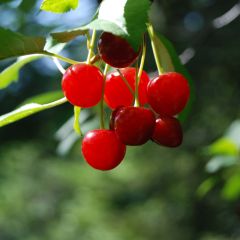
Dwarf Cherry Tree Cherry Boop
- Flowering time April, May
- Height at maturity 2 m
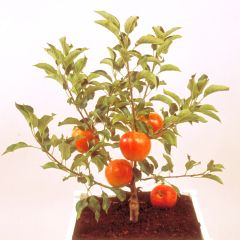
Dwarf Apple Tree Garden Sun Red - Malus domestica
- Flowering time May
- Height at maturity 1,50 m
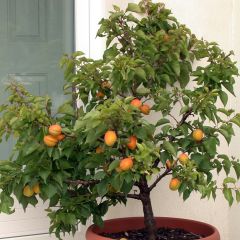
Prunus armeniaca Garden Aprigold - Apricot Tree
- Flowering time April, May
- Height at maturity 1 m
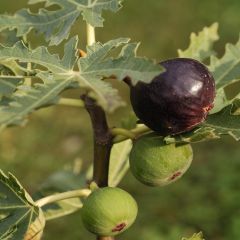
Ficus carica Ice Crystal
- Flowering time August
- Height at maturity 2 m
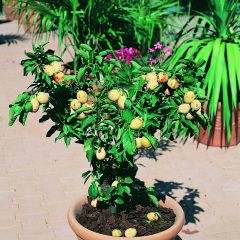
Prunus domestica Goldust - Common plum
- Flowering time May
- Height at maturity 1,50 m
Discover other Fruit trees for small gardens
View all →Available in 2 sizes
Available in 0 sizes
Available in 0 sizes
Available in 1 sizes
Available in 0 sizes
Available in 0 sizes
Available in 0 sizes
Available in 2 sizes
Available in 1 sizes
Available in 1 sizes
Where and how to plant?
In the ground or in pots, fruit trees should be planted in full sun, preferably in a location sheltered from cold winds.
Planting in the ground:
In the garden, dwarf fruit trees are planted in the same way as standard fruit trees. Since the growth of these trees is less vigorous, it is possible to significantly reduce the planting distances and plant them every 1.5 metres.
To learn everything, discover our advice sheet: “Planting Fruit Trees”
Planting in pots:
These fruit trees should be planted in large containers with a diameter of 40 to 50 cm (minimum 25 litres). Prefer soil fibre or traditional terracotta over plastic, which heats up quickly in summer. Cultivation bags like smart pots also yield excellent results. Orange crates or orangerie boxes, which are elegant, are certainly perfect but their cost is often prohibitive.
In practice, to plant:
- Start by checking that your pot has drainage holes at the bottom. If not, drill them.
- Ensure proper drainage by placing a layer of clay balls or gravel at the bottom of the pot,
- Fill the pot with very good potting soil or, for the best-equipped gardeners, a mix composed of 50% standard potting soil, 30% well-decomposed compost, and 10% perlite to improve drainage.
If your tree has bare roots:
- Start by “dressing its roots”. This operation involves cutting, with clean pruning shears, any damaged or excessively long roots to achieve a clean cut,
- Then, coat the roots with a mixture of one-third potting soil (or cow dung… but that can be tricky to find!) and clay soil mixed with rainwater until it forms a mud that adheres to the roots. Note that commercially available pralin can be reconstituted by simply adding water.
Then, in all cases:
- Place your tree, taking care to not bury the grafting point,
- Add potting soil to ensure that the entire root ball is in contact with the substrate,
- Proceed with an initial watering
- Mulch with your choice of material or plant a few strawberry plants or lovely herb plants like golden oregano at the base of your fruit tree.
Pruning dwarf fruit trees
Dwarf fruit trees are pruned like other fruit trees. However, as their growth is slower, this operation is spaced out more. Moreover, they can easily be satisfied with a single thinning pruning, which is done somewhat instinctively and does not require great skill.
Although they produce slightly less than standard fruit trees, these mini trees can, in the early years, be overloaded with fruit. To avoid placing excessive weight on the branches, which could risk breaking them, and also to achieve good-sized fruit, do not hesitate to remove a few early on… It’s often a heart-wrenching task, but it is necessary!
Caring for dwarf fruit trees
The regular maintenance of container fruit trees involves ensuring that the soil does not dry out, while not overwatering. If your pot has a saucer, never let water stagnate in it to avoid root asphyxiation.
Once a year, repot your fruit tree into a slightly larger pot and take the opportunity to refresh the potting mix. If this is not possible, proceed with top dressing.
What is top dressing? This technique involves carefully removing 4 to 5 centimetres of substrate from the surface and replacing it with a mixture of potting mix and well-matured compost. This operation allows for easy fertilisation of the soil without having to replace the entire substrate.
In the garden, proceed in the same way by spreading a bucket of well-decomposed compost at the base of your dwarf fruit tree each autumn or spring.
A balcony orchard: what to combine with a small fruit tree?
Dwarf fruit trees can be accompanied by some strawberry plants in pots. On the balcony or terrace, to create a “mini-orchard”, it is also possible to install many red berries in large pots or large rectangular planters: raspberry, blackcurrant, redcurrant, as well as less common species like goji or Tayberry. If you have a large pergola, consider the Kiwai, a truly adorable mini-kiwi!
Discover our range of fruit trees for small gardens!
- Subscribe!
- Contents































